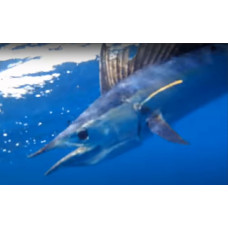Latin name
Tetrapturus angustirostris
Other names
Shortnose spearfish; Arabic: kheil; Hawaiian: a’u; Japanese: fûraikajiki.
Identification
Body is powerful, elongated, strongly flattened from sides, its height is 8,3-10,4 times of body length. Snout in form of elongated, spear-shaped, rounded in cross-section rostrum, which length (from its apex to eye) is less than 15% of body length. The upper profile of the head is smooth without sharp rise at the occipital part. The gill flaps are closed on, but are not attached to the gill gap. The gill arches have no gill stamens. Dorsal fins are two, located close to each other: the first fin with a long base and a high, pointed front blades, the height of which is slightly higher than the height of the body in its front part. The fin's height gradually decreases until about the 19th ray, then increases again, and at the middle part of the fin its height is slightly less than the body height below that point. The second one is with a short base, shifted closer to the caudal peduncle. The anal fins are two. The first fin has a slightly longer base than the second, with a high pointed front blade. The second is equal in length and height to the second dorsal fin and slightly forward relative to the latter. The pectoral fins are short (less than 18% of the body length) and wide, tightly clamped to the sides of the body. The length of the pelvic fins exceeds the length of the pectoral fins, their ends are at a considerable distance from the anus, they have a moderately developed membrane, can hide in a deep groove on the belly. The caudal peduncle is strongly flattened from the sides, it has well-developed paired keel. The anal opening is located in front of the beginning of the first anal fin at a distance greater than the height of this fin. The lateral line is clearly visible, with a slight curve above the pectoral fin. The body is covered with elongated, pointed, thick bony scales with 3 to 5 serrations at the end. The body is dark blue with a subtle brown tinge on the sides, and the belly is silvery white. The first dorsal fin blue, without any points or spots, the remaining fins are brown or dark brown. The bases of the anal fins are silvery white.
Distribution
It inhabits tropical, subtropical and temperate waters of the Pacific and Indian Oceans. In the northwestern part of the Pacific Ocean its northern boundary of distribution is at 45°N, in the northeastern part - about 35°N. In the southwestern part it does not occur south of 35°S, in the southeastern part it reaches 25°S. In the Indian Ocean, the southern limit of its distribution is 45°S. According to some data, the fish occurs occasionally in the eastern part of the Atlantic Ocean, off the southwest coast of Africa, but its reproductive range is obviously limited to the waters of the Indian and Pacific Oceans.
Habitat
A representative of the open ocean ichthyofauna, it rarely enters coastal waters. Japanese longline fishing statistics indicate that Shortbill spearfish are quite rare in the epipelagic zone (from the surface to 200 m depth), with the largest catches recorded in the 915-1830 m depth range. It does not usually form clusters of high density, except in the northwestern Pacific, between 15 and 30°N, where it is quite abundant in catches from November to February. In the Indian Ocean, it is most commonly found in catches during the southeast monsoon, with water surface temperatures of about 25.5 °C.
Size
Length can reach 2 m, weight - 52 kg. The average length of fish in catches usually does not exceed 150 cm, with a weight of about 18 kg.
Life history and Behavior
It spawns in tropical and subtropical regions, from 25°N to 25°S. The most active spawning seems to occur during the winter months, when the water temperature at the ocean surface is 25°С.
Food and feeding habits
The diet of the Shortbill spearfish is highly dependent on the area of habitat. In the eastern part of the Pacific Ocean, it feeds mainly on cephalopods and fish (mainly members of the mackerel, flying fish, sea bream, butterfish, and lancetfish families). In the central part of the South Pacific, it feeds less on fish food, preferring crustaceans and cephalopods. In the Indian Ocean, around the Seychelles-Mascarene Ridge, squid, small tuna, and mackerel are noted in the food.
Reproduction
Spawning occurs in batches. Almost mature eggs in the ovaries are colorless, translucent, about 0.8-1 mm in diameter, and have a yellow-brown fat drop. The diameter of hatched eggs is 1.3-1.6 mm.
| Classification | |
| Phylum | Chordata |
| Class | Actinopterygii |
| Squad | Istiophoriformes |
| Family | Istiophoridae |
| Genus | Tetrapturus |
| Species | T. angustirostris |
| Features | |
| Conservation status | Data Deficient |
| Habitat | Pelagic |
| Life span, years | No information |
| Maximum body weight, kg | 52 |
| Maximum length, cm | 230 |
| Sailing speed, m/s | No information |
| Threat to people | Edible |
| Way of eating | Predator |

